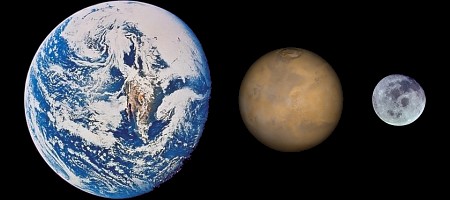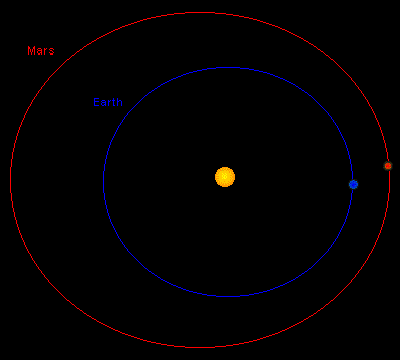

| Earth | Mars | Luna (Moon) | |
| Mass | 5.98 x 1024 kg | 6.42 x 1023 kg | 7.35 x 1022 kg |
| Comparative mass | 1.00 | 0.107 | 0.0123 |
| Diameter | 12756 km | 6787 km | 3476 km |
| Escape velocity | 4.03 x 104 km/hr | 1.80 x 104 km/hr | 8.57 x 103 km/hr |
| Average distance from Sun | 1 AU (1.496 x 108 km ) | 1.524 AU (2.280 x 108 km) | 3.84 x 105 km (from Earth) |
| Rotation period | 23.93 hr | 24.66 hr | 27.32 day |
| Revolution period | 365.26 days | 686.98 days | 27.32 day |
| Mean surface temperature | 286 K (13 șC) | 216 K (-57 șC) | 243 K (-30 șC) |
| Atmospheric components | 78% nitrogen 21% oxygen 1% argon 0.035 % carbon dioxide |
95% carbon dioxide 3% nitrogen 1.6% argon 0.13% oxygen |
negligible |
| Atmospheric pressure | 101.3 kPa | 0.7 kPa | 0.0 kPa |
Mars has a mass only one tenth of the Earth's, its year is almost twice as long, but its day is nearly the same length. There is a great difference in the average surface temperature of the two planets. Luna, Earth's moon, is only about one eightieth the mass of the Earth. Since it has no atmosphere, it has extreme surface temperature variation, from as high as +130 șC in the sunlit daytime, to -170 șC in the dark at night.
The atmospheric composition of Earth and Mars is not at all the same. Mars has a very small atmospheric pressure, only about one hundredth that of Earth, and its atmosphere is almost entirely carbon dioxide. The percentage amount of carbon dioxide in the earth's atmosphere is very low (since it is in an equilibrium maintained by its solubility in water, and its use by green plants in photosynthesis). The Moon has no atmosphere at all, except for traces of solar wind gases, that quickly escape into space.
Comparison of Mars and Earth orbits shows that Mars' is much more eccentric than the Earth's. Because of this, and because of the difference in their period of revolution, the distance between Earth and Mars can vary greatly.

At its closest approach, Mars is about 50 million km from Earth; at its farthest almost 402 million km (when Earth and Mars are on opposite sides of the Sun). The average distance between Earth and Mars is over 200 times as far as it is from the Earth to the Moon.